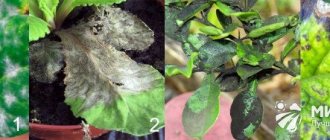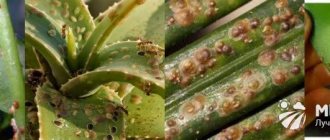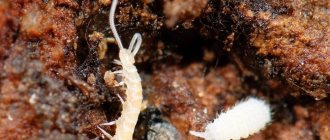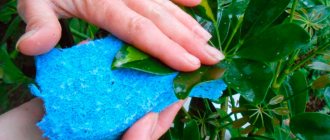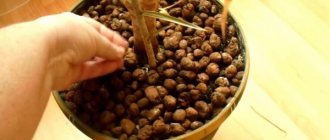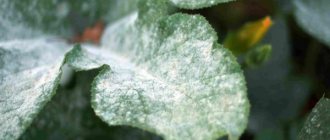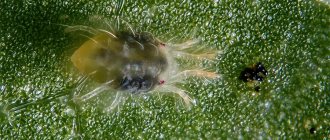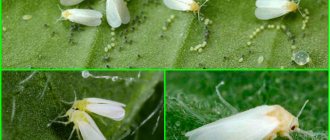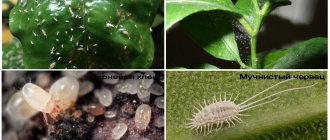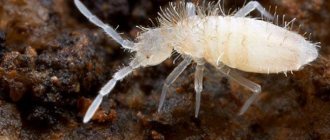Whitefly
Pests of indoor plants (photos and names of insects are presented in the article for basic reference) in the form of whiteflies have a body length of up to 2 mm. A distinctive feature is the body, which has a yellowish color and white wings.
You can detect the parasite as follows:
- on foliage from the underside;
- along a sweetish trail, in place of which a sooty fungus appears.
The insect feeds on plant sap, which leads to loss of its attractiveness. It can be found on pelargonium, begonia and hibiscus. You can fight the pest by washing the foliage with a solution of laundry or liquid soap, sticky traps or ash. Plants can be sprayed with insecticides such as “Prestige”, “Commander”, “Aktara”.
Description of pests
Pests of indoor plants can cause harm and lead to the death of green spaces if they are not dealt with. Let's look at the most common insects and their destructive activities.
Spider mite
Spider mites are the most common “guest” on indoor plants. Due to their small size, they cannot be seen with the naked eye. You need to examine the lower part of the flower, because these pests do not tolerate light and moisture. Insects may appear in a dry and hot room. In such conditions, the development of spider mites is rapid.
If you have geraniums, hibiscus, palm trees, aspidistra, then they need to be inspected constantly. Insects pierce the tender part of the leaves and suck out the juice. As a result, the leaves become faded and crumble.
Aphid
Aphids can be seen despite their small size. They come in black and green. Insect colonies multiply rapidly: the female lays at least 150 larvae, which after 7 days themselves enter the reproduction stage. Females of the third generation have the ability to fly. They move onto any indoor plants and lay larvae. Diseases are transferred to flowers on their paws, for example, different types of flower mosaics. Getting rid of aphids is not as easy as it seems.
Shields
Scale insects on indoor plants are a dangerous pest; they love to settle on cuttings, leaves, and stems. It is not difficult to detect: it is flat, oval, with the lower part of its body tightly adjacent to the substrate.
These pests are different. Real scale insects hide under their shells, just like turtles. False scale insects do not have this possibility, since this part of the body is inseparable.
The favorite colors of these pests are:
- lemons;
- oranges;
- tangerines;
- asparagus;
- oleanders;
- ivies;
- palm trees
Scale insects settle on the lower part of the leaf. Colonies develop quickly. Slowly moving dots appear on the leaves, somewhat reminiscent of plaques. The leaves around their habitat turn yellow. Insects suck out the juice of tender plants and shoots, depleting the plant. If you do not start a timely fight, indoor flowers die.
Thrips
Ficus, begonias, dracaenas, and palm trees are affected by a small jumping beetle - thrips. The females make holes in the leaves or flower buds and lay eggs. The damage is microscopic and impossible to notice with the naked eye. A signal that thrips are on indoor plants is a silvery pattern appearing on the leaves. The insects themselves live on the back side of the leaf.
White Podura
These creatures can also jump. This is a soil insect that lives directly in pots. It is distinguished by an elongated body, on which sparse hairs are visible. There are antennae on the head. Most often they appear in soils rich in humus.
The basis of nutrition is plant residues, but it does not disdain the living root system. It is clear that the eaten roots can no longer cope with their function, the plant slows down its growth and may die.
Mealybugs
These are white worms; they love the back of the leaf in the places where the vein runs. Females are large, up to half a centimeter, very fertile. They build houses for their offspring that look like balls of cotton wool, and lay eggs in them. The hatched larvae are mobile and quickly conquer space on the flowers. Gardeners who grow azaleas and cacti need to constantly inspect their plants for signs of mealybugs. These pests of indoor plants prefer them and it is necessary to take immediate measures to combat them.
Whitefly
Whiteflies are, by and large, greenhouse insects. If you purchased flowers in these places, do not be lazy to examine them carefully. Even one female whitefly on indoor plants will produce huge offspring in a short time. Then the question will arise of how to fight. The pest's favorite flowers are fuchsias, ferns, and geraniums. The two-millimeter insect feeds on plant sap, and as a result it weakens and withers.
Fungus gnats
It often happens that flower growers notice small flies flying around their flowers, but do not attach any importance to it. And in vain, because the fly lays larvae in moist, fertile soil. The larvae are microscopic, so their appearance is not immediately noticeable. The danger of insects is that the smallest creatures feed on the root system of plants. As a result, the flower dies.
Fungus gnats
The fungus gnat is presented in the form of a black midge that sucks juice from the roots of plants. They can appear on any indoor plants. To detect the pest, it is enough to remove the top layer of soil.
You can fight insects by drying the soil mixture in a pot. Such drugs as “Mukhoed”, “Aktara” and “Inta-vir” will help to remove the larvae. Additionally, you can use Raptor spray.
White fool
White durs are jumping insects that can be found on potted indoor plants. They differ from each other:
- Prefers an environment with high humidity.
- Having 3 pairs of legs.
- The body is elongated with sparse hairs.
- Long mustache.
The diet of these pests includes the remains of plant components, as well as a living root system. If you do not notice and begin to fight these pests in time, they can lead to the death of indoor plants.
Caterpillars
Caterpillars are small worms with a body length of up to 2 cm. The larvae are variegated or monochromatic in color. They feed on the fleshy part of the green mass; some representatives wrap the leaf in a silk thread. The appearance of caterpillars is fraught with damage to the plant’s immunity. It weakens and can be susceptible to various diseases.
Pests can be found on cyclamen, balsam or geranium. You can protect the plant from the caterpillar by treating the foliage with a soap solution and then washing it with hot water.
Weevil
Pests of indoor plants (photo and name will help gardeners correctly identify a dangerous insect on a flower), presented in the form of weevils, have a body length from 1 mm to 3 cm. The body shape is oblong and slightly flattened.
The color can vary from black to yellow, and in some cases spots can be found on the surface of the body. A characteristic feature is the elongated front part of the head, due to which the insect got its name.
The weevil does not go through plants, so it can be found almost anywhere where crops are present.
After laying eggs, the larvae eat the buds, which causes a lack of flowering. Adults chew on foliage and petals, leaving indentations. If an insect penetrates the roots, the crop dies. The pest must be controlled by spraying the plant with preparations such as Bona Forte, Fitoverm and Actellik.
Other pests
This group can include hooligans, who are familiar to many gardeners, but differ from those described above.
Garden slug
garden slug
Or slug is actually a mollusk that, in the process of evolution, has lost its shell. In the garden, slugs often misbehave, damaging bulbous and root plants, eating young shoots and non-woody parts. In addition, moving from one object to another, they spread fungal infections. Active in wet weather! How to deal with slugs? Keep in mind that slugs love damp and dark places, so compost heaps should be insulated, and dry grass should not be left near flower beds and beds (see below).
- At risk: bulbous and tuberous plants, young shoots.
Root mites
root mites
They are sucking insects, but operate underground, feeding on bulbous plants. This is a very small pest, about 1 mm. long, but living in colonies. In hot weather, mites fall asleep, and in cool and humid conditions they multiply quickly and require a lot of food, which becomes organic plant debris, as well as roots and bulbs of plants, on which their activity is immediately reflected by the death of foliage and flowers.
- At risk: all bulbous plants.
Garden ants
garden ants
Workers in the world of insects often turn into a real “headache” for gardeners, multiplying very quickly and feeding not only on insect pests, but also on plants. Ants love berries, vegetables, and buds, considering unopened peony buds a special delicacy. As a result of their occupation, the flowers do not open or look “gnawed”. Fortunately, ants are easy to spot, and they often make friends with aphids, feeding on the sticky juice that they secrete.
- At risk: all plants, especially peonies and phlox at the bud stage.
Root mites
The root mite is small in size, has up to 3 legs, an oval light transparent body and sharp antennae. Destroys the onion from the inside; if you try to put pressure on it, it will fall apart and turn into dust. Root mites eat bulbous plants such as hyacinths, tulips, orchids and gladioli.
If an insect attacks a plant, it must be treated with insecticides, and diseased flowers must be isolated from healthy ones. The diseased crop must be removed from the soil layer, the roots and bulbs washed and soaked in an insecticidal solution. For prevention, pots in which infected plants grew should be washed and boiled for 20 minutes.
Prevention
Thrips are very delicate insects; they cannot withstand low temperatures and high humidity. Thrips are rarely found in winter and autumn, but in the spring and summer you need to be careful and periodically inspect the plants to avoid infestation. The plant needs to be sprayed, at least occasionally, but it is better that the air humidity in the room is quite high. Plants need to be provided with a flow of fresh air, but avoid drafts; drafts have a negative effect on many plants. If you find an affected plant, it should be isolated, and all other plants should be properly sprayed and wiped with a damp cloth. With the onset of spring, some plants can be given a shower.
Mining flies
Mining flies are presented in the form of small insects with transparent gray wings and a body length of up to 3 mm. They lay translucent, whitish or yellowish eggs on the underside of foliage. Generation duration ranges from 20 to 35 days.
Harm to the plant is caused when its tissue is pierced by drinking the juice. The pest can be found on chrysanthemums and violets. If masonry is detected, the affected leaf will need to be removed and the plant treated with one of the following preparations: “Karbofos”, “Aktellik”, “Aktara”, “Tanrek”, “Apache”.
woodlouse
Indoor plants can be attacked by an insect pest called Woodlice, which has an oval-shaped body with a small bulge at the top (the photo will help you recognize the insect on the crop). The parasite belongs to the family Crustaceans and Isopods.
Eats plant roots, fresh rotted organic matter, underground shoots and soft tissues of crops located near the surface of the substrate. Loves dark and warm conditions. The insect emerges from its hiding places at night. Since it leads a hidden lifestyle and is small in size, it can cause significant damage to the flower.
The pest can be recognized by lesions in the form of holes or pits in the soft parts of the flower. Appears on cacti, ferns and orchids.
For prevention, you should constantly remove any remaining vegetation in the container. To prevent wood lice from getting on the crop, containers must be placed on a pallet.
The fight against woodlice is based on the use of a drug called Pyrethrum, since insecticides have practically no effect on the insect. Another means of control is traps. One of them can be created from a potato, cleaning it from the inside and placing it next to the plant in a pot. Over time, all the insects will accumulate inside the trap and can be removed.
Prevention of garden pests
In the struggle for the beauty and health of the garden, preventive measures are most often sufficient, which involve regular care of the flower beds. As a rule, pests avoid treated areas! The website flowery-blog.ru recommends procedures that will be useful for prevention purposes.
- Inspect the plants more often to notice traces of the pest in time: the sooner you detect it, the more effective the measures taken will be. If curled leaves (leaf roller) are noticed on a plant, they must certainly be destroyed, and this should be done in such a way as to prevent the caterpillar from escaping by squeezing the leaf with your fingers.
- All dried shoots that cause suspicion (sawfly) must be removed in a timely manner; good results are achieved by regular formative pruning of bush crops, during which old and dry branches are discarded.
- Preventive digging of the soil in the fall before wintering, and in the spring after removing the winter shelter, is of great importance. Thus, you can destroy and repel pests that overwinter in the soil!
- Weed control is good for plants in general! Remove even small shoots, loosen the ground around the bushes as often as possible to block the path for weeds, which often become “suppliers” of various parasites.
- Remove the winter shelter in a timely manner so that it does not become a haven for harmful larvae and slugs, which love to hide in such places.
- As the bulbous plantings grow, it is necessary to cull unhealthy and weakened bulbs. If a sick plant is noticed in a flowerbed, it must be dug up and examined. Perhaps an underground pest is to blame!
- Before planting, it is recommended to dig up the soil along with the ash. This organic component repels many pests, including ants. It can also be sprinkled on plant leaves and buds to render them “unfit” for consumption.
- There are plants that repel the enemy. Usually these are herbs with a pungent odor, or spicy greens, and sometimes varieties from the world of flowers. So, you can dilute the flower garden with basil, mint, or sage, and plant onions or garlic around the flower bed. Among the flowers there must certainly be marigolds, or matthiola, calendula, or gypsophyll.
- At the initial stages, folk remedies, the use of infusions and decoctions give good results. Such proven natural recipes can be used as a preventive measure at any time, without fear of harming the plant. All traditional methods are collected in this article.
✿
Mealybug
The body of the mealybug is covered with a powdery coating that resembles fur. Grayish or cream-colored parasites are easy to spot against the green background of the plant. They gather in small groups and secrete honeydew.
The liquid attracts fungus, which becomes an additional threat to the plant. The louse digs into the soft tissues of the flower and sucks the juice out of it. The pest appears on orchids, fuchsias, palm trees, hibiscus, and cacti.
If detected, foci of infection must be immediately treated in one of the following ways:
- treatment with soap solution, which is made from 1 tsp. grated laundry soap diluted in 1 liter of water;
- you will need to completely change the soil, rinse the root system of the flower with hot water, the temperature of which reaches 50 °C;
- wiping the affected areas with an alcohol-based solution;
- manual collection of insects followed by washing the green mass of the plant under a shower head.
Plants can be treated with chemicals such as Karbofos, Aktara, Confidor.
Plant pests
Insects are one of the most ancient, numerous and diverse groups of animals on Earth - more than a million species, distributed everywhere and play a huge role in the biological cycle of substances, soil formation and plant pollination. Many types of insects are pests of ornamental and agricultural crops. PESTS OF PLANT ROOT SYSTEMS
May beetles are particularly dangerous and widespread pests of tree species. These beetles measure 17–31 mm. In Russia there are 9 species of May beetle, the most harmful is the Eastern May beetle (Melolontha hippocastani). In May, emerging from the soil, the beetles rush into the crowns of trees for additional nutrition. The leaves of oak and birch are most damaged by beetles. apple trees, poplars. and you. 6 - 8 weeks after the start of flight, larvae appear. Further development of the larvae occurs in the soil, and they first feed on thin roots and humus, and then switch to feeding on thicker roots, bulbs and root crops. In damaged plants, the water regime is disrupted, they do not receive normal nutrition and, depending on the degree of damage, may die.
Control measures: compliance with agrotechnical requirements for growing each crop; attract birds to your gardens - one pair of starlings, while feeding their chicks, brings them up to 8,000 cockchafers and their larvae; if beetles appear en masse, shake them off onto a cloth spread under a tree and destroy them; in the fight against larvae - the use of biological preparations based on nematodes “Nemabakt” and “Antonem - F”; treating the garden with insecticides (Decis, Actellik).
Mole cricket is a large (up to 50 mm) insect that leads an underground lifestyle. The most common mole cricket (Gryllotalpa gryllotalpa). The mole cricket is found mainly in damp low places, loose soils rich in organic matter, along the borders of waterlogged areas, especially loves manured soil, moves at shallow depths, makes nests at a depth of 10 - 15 cm, winter burrows reach a depth of 50 - 100 cm. The pest damages underground parts of various plants (root crops, roots).
Control measures: attracting birds to gardens; use of poisoned baits; treatment of the roots of seedlings before planting in the ground with a suspension of the drug "Aktara"
SUCKING PESTS OF PLANTS
WHITEFLY (Aleyrodidae) is a small flying insect (body length 1 - 2 mm) a bit like a miniature white moth, whose wings are covered with a waxy coating similar to flour. Plants are damaged primarily by whitefly larvae, which suck the juice from the leaves, preferring young foliage. When severely damaged, they colonize all parts of the plant. Of greater danger are the sugary secretions of the larvae, which create ideal conditions for the life of a sooty fungus that clogs the stomata of the leaf and closes it from light. The leaves gradually curl and fall off. As the larvae grow, they become covered with a waxy coating and become inaccessible to the action of chemicals.
Control measures: use yellow glue traps to catch adults; two - three times spraying with solutions of insecticides (actellik, kinmiks, karbofos).
Aphids (Aphidoidea) are small insects, the size of which does not exceed a few millimeters. About 4,000 species of aphids are known. All aphids feed on plant juices; many are capable of spreading plant diseases in the form of viruses and causing various abnormalities in plants, such as galls. Insects are clearly visible to the naked eye, and aphid infestation is also indicated by deformed shoot tips, curled leaves, and sweet discharge (honeydew) on leaves and shoots. Subsequently, sooty fungus and ants appear on these secretions. In affected plants, the leaves curl and turn yellow, the buds do not develop or produce ugly flowers.
Control measures: in case of minor damage, you can spray with infusions of tobacco, celandine, onions, onion peels, and dandelion; in case of severe infestation - chemical methods of control using insecticides (actellik, actara, decis, fitoverm).
SALIVARY FOAM (Philaenus spumarius) is an insect up to 10 mm long, from light yellow to brown. Adults and larvae feed on plant juices. The larvae are white, greenish-yellow when older, and are found in a foamy, saliva-like liquid. which protects them from drying out. Damaged leaves are deformed and wrinkled.
Control measures: spraying plants with one of the drugs - actellik, inta-vir, fitoverm, fufan, actara.
FAMILY HERMES (Adelgidae) is a large group of aphids that develop on conifers. This is an insect with a dark brown color, with waxy fibers similar to white fluff on the sides, and in adults throughout the body. Hermes lives in colonies and settles on the needles and shoots of plants, forming a white fluffy coating. By sucking out the juices, pests inhibit and weaken plants, retard their growth, cause bending, wrinkling, twisting of damaged shoots and needles, tissue proliferation and the formation of galls, growths, and nodules.
Control measures: double treatment with systemic insecticides (actara, fufanon, confidor, etc.).
COCCIDAS (Coccoidea) are small insects (body length 1 - 7 mm), characterized by a unique body structure. They include 7 families, but most of the coccid species that damage tree species belong to 3 families: scale insects, false scale insects and mealybugs. Coccids are perhaps the most dangerous pests found in our gardens. They are inconspicuous, difficult to distinguish, spread easily, and are protected from external influences, including chemical control agents.
SCALE (Diaspidida) - got its name from the round or elongated shield that covers the pest. The shield is formed from the skins remaining after the molting of the larvae, as well as wax and other secretions of the skin glands. Such a shield is not an integral part of the body and is therefore easily separated. Scale insects have several types, differing in size (0.5 - 5 mm) and color (from white - gray to brown). This is a fast-growing pest. At the initial stage of development, scale insects are very mobile and can quickly spread throughout the plant and infect neighboring ones. Adult females are motionless, males are much smaller than females, have one pair of wings and normally developed limbs. Damaged plants turn yellow, develop incorrectly, leaves fall off, and young shoots dry out.
FALSE SCALE (Lecaniidae) is an insect 3-7 mm in size that does not have a scutellum, but the upper surface of their body is highly chitinized, hard and resembles a scutellum in appearance. It affects many deciduous trees (white acacia, maple, ash, poplar, hazel, etc.). By sucking juice from leaves and shoots, the false scale insect secretes a large amount of honeydew, on which sooty fungi develop, covering the leaves and branches with a black coating, making it difficult for plants to breathe and feed. Damaged plants weaken, their productivity and frost resistance decrease, and severely damaged trees may die.
Mealybug (Pseudococcidae) is a white insect up to 5 mm in size, the entire body of which is covered with waxy secretions in the form of a mealy coating. The pest moves well at almost any age. It gathers in colonies, mainly along the veins on the underside of leaves, in the axils of leaves, on petioles and stems, where it forms white cotton-like secretions in which females lay eggs. The female is wingless, elongated-oval, with projections and long setae along the edges. males have wings, normally developed limbs, an abdomen with two tail filaments or a bunch of them. Plants are damaged primarily by larvae, which suck the juice out of it and at the same time inject toxic substances that slow down the growth and development of the plant. Damaged plants have deformed flowers, buds and leaves.
Control measures: double treatment with insecticide solutions (actara, decis, karbofos, etc.); as a preventive measure, garden care, removal of old branches that thicken the crown; When purchasing, carefully inspect the plants to detect pests.
PLATES or PSYLLIDAS (psyllidae) are small insects 1.5 - 4.0 mm in size, with piercing-sucking mouthparts. Adult copperheads have two pairs of roof-shaped wings and hopping hind legs. Larvae and nymphs of honeydews feed on the underside of leaves, petioles, pedicels and shoots. Traces of their damage are numerous light spots, often grouped on the periphery of the leaf blade. The pest damages many species: apple tree. pear, lilac, linden, birch, etc. By sucking juices from plants, copperheads cause drying of leaves and shoots, falling off of buds, flowers, ovaries, slowing down plant growth, and contaminate leaves and buds with honeydew. Adult insects overwinter in cracks in tree bark and under fallen leaves.
Control measures: treatment of affected plants with a solution of decis, karbofos, etc.; regular garden care.
SPIDER MITES (Tetranychidae) are very small pests from the class of arachnids, ranging in size from 0.3 to 1.0 mm. The body of the pest is round, from yellowish to bright orange or red. They are found both on deciduous trees. and on coniferous woody plants, they harm herbaceous plants, plants in greenhouses and greenhouses, and indoor flowers, producing several generations a year. At first, spider mites settle mainly on the underside of the leaves, then they appear on the top, weave a thin web and lay eggs. Damaged leaves and needles turn brown and dry out, and the buds often do not open.
Control measures: spraying plants with one of the drugs: Actellik, colloidal sulfur, Fitoverm, Fufanon.
CHEATING PESTS OF PLANTS
Weevils (Skosari or Elephants) (Curculionidae) are a large family of herbivorous beetles, a characteristic feature of which is the elongated front part of the head - the rostrum, which is why they received their Russian names.
RASPBERRY-STARWBERRY WEEEL (Anthonomus rubi) is a beetle 2.5 - 3.0 mm long, black in color, sometimes with a brown tint, covered with thick light gray hairs. The pest damages strawberries, raspberries, roses, as well as herbaceous plants from the Rosaceae family. They feed on plant leaves, eating deep holes and small through holes in them. Females lay eggs in the buds and gnaw the peduncle, causing the bud to break and fall off. young beetles emerge in mid-summer and feed on leaves until autumn. Beetles overwinter under fallen raspberry and strawberry leaves. With a large number of pests, the yield of berry crops and flowering of shrubs decreases.
ELEPHANT - BOOKARK (Coenorrhinus pauxilus) seriously damages fruit trees. The beetle is about 3.0 mm long, dark blue with a greenish tint, and overwinters in the soil around the tree trunks. In the spring, with the onset of warmth, the beetles come to the surface and fly up into the trees. They gnaw through the buds of apple, pear, cherry, viburnum, euonymus, etc. By attacking very young buds, they can destroy the entire shoot. In May, the female lays eggs, for which she makes a hole on the underside of the median nerve of a young leaf and lays an egg in this hole - one on each leaf. Then it moves to the petiole of the leaf, makes one or two punctures on it, as a result of which the leaf bends, dries out and falls off.
GREEK ELEPHANT (Rhynchitsbacchus) - harms apple, pear, cherry, plum, peach and apricot trees. The beetle reaches 4-7 mm, the body is shiny, copper-red, the head-tube, antennae and legs are purple. Pests appear in early spring and first feed on the buds, then eat the buds and pulp of the leaves. Females lay eggs in fruits that are beginning to form. To do this, she gnaws out a small chamber in the pulp of the fruit, places an egg there and covers the hole with excrement and gnaws the stalk. At the same time, fungi are introduced into the wound, causing fruit rot. Otherwise, the elephant larva does not develop. Damaged fruits rot and fall to the ground.
PINSODESNOTATUUS (pissodesnotatus) is a small pine weevil that damages pine, as well as larch fir. The beetle is 5 - 7 mm long, the body is dark brown with two bands on the elytra. The beetles feed on the tops and branches of young pines, plunging the rostrum deep into the bark, while resin flows out of the wound and forms a shiny dot on the bark. Eggs are laid in depressions gnawed out in the lower part of the trunks and at the root collar of young weakened pines. The larvae gnaw tunnels under the bark and overwinter under the bark (beetles or larvae). In the spring, they gnaw a hole through which it flies out. The pest is most dangerous for young (4 - 15 year old) pine crops and can cause them to dry out.
APPLE FLOWER BEETLE (Anthonomusponorum) is a beetle with a body length of 3.5-4.5 mm, brownish-brown in color. The beetles overwinter in cracks in the bark, in the soil under fallen leaves, come to the surface in the spring and begin to feed on the buds of apple, pear, and less often hawthorn, gnawing deep holes in them. The female lays eggs in the buds. In years when the number of beetles is very large, they begin to feed on the leaves of rose hips and roses, skeletonizing them in the same way as the leaves of an apple tree.
Control measures: regular garden care, shaking off and destroying beetles, spraying plants with a solution of one of the drugs: Decis, Inta-Vir, Actellik, Fufanon, etc.
Nematode
Pests of indoor plants (the photo and name will allow you to identify the insect that appeared on your home crop) can be presented in the form of microscopic nematode worms that parasitize the tissues of flowers from the inside. The reason for their spread is soil mixture contaminated with eggs. Nematodes can be root or leaf nematodes.
In the presence of a root pest, tumor swellings develop on the roots. Because of this, the root system stops working. The foliage begins to lose turgor. In advanced cases, small shiny black-brown balls may be present on the roots, if the soil is removed from them. These galls can withstand toxic chemicals and heat treatments.
If a crop is affected by a leaf parasite, the green mass stops growing. Dry streaks in the form of spots form on the plate. From below, between the veins, shiny spots of red or brown color develop.
Later, the foliage begins to turn yellow, thin and deform. As a result, it dries out or rots. Brown scars form on the flower buds. Plants such as cactus, begonia, ficus, dracaena or lily may be susceptible to insect attack.
Pest control method:
- If infected with a root nematode, re-root the flower with a cutting or leaf.
- Remove or burn the mother crop with the soil layer.
- Sterilize the pot in which the plant grew.
Nemafos and Dekaris are suitable chemicals. The culture can also be disinfected using hot water, the temperature of which can be from 45 to 90 ℃. Heat treatment lasts from 5 to 30 minutes.
Control measures
How to get rid of pests? This question haunts many indoor plant lovers. Realistically control pests in a variety of ways. For example:
- Based on folk recipes.
- With the help of biological drugs.
- Mechanically.
- Using chemical control measures.
Mechanical method
This is an environmentally friendly, simple and inexpensive way to control pests yourself. Use a tool, preferably disinfected, and cut off the damaged parts. It is best to treat cut areas with activated carbon. Pests that are visible to the naked eye can be easily caught by hand, provided that the plants and pests are not too numerous.
Interesting recipe! A contrast shower can rid indoor plants of pests. Just spray the flower with water, then wipe the leaves with cotton wool, and the problem will be solved.
Folk remedies
Many lovers of indoor plants, in order to protect them from various insects, as well as in case of their diseases, prefer folk remedies. These products have been tested for many decades, so there is no doubt about their effectiveness. Decoctions based on plants such as chamomile, nettle, yarrow, dandelion or calendula are absolutely harmless to humans and plants. Solutions based on garlic and onions have the same effect. The prepared solutions are simply sprayed onto the plants almost daily.
An alternative is to use citrus peels that are simply buried in the ground. The smell of these ingredients is unbearable for many parasites that want to settle on indoor plants.
Solutions based on wood ash, furatsillin, baking soda or potassium permanganate are no less effective. It is only necessary to prepare the solution correctly, after which the plants are sprayed with a spray bottle.
It is important to know! If you add a little soap, preferably household soap, to the solutions, the product will not drain from the leaves so quickly, which will enhance the effect of the drug.
Biological method
Biological preparations are distinguished by the fact that they act only on certain types of pests and are safe for people and pets. However, the work preparation must be properly prepared and applied correctly. For example:
- The room should be well ventilated.
- The solution must be prepared strictly in accordance with the instructions.
- After treatment, the plant must be left to dry.
To do this, you can use control agents such as Agrovertin, Fitoverm or Iskra-Bio.
Chemical method
The chemicals are very effective, so you can get rid of all the pests in a short time. The only problem is their toxicity, which is dangerous for both people and pets. It is better to use such drugs as a last resort, especially since they cannot always be used.
We must remember! The use of toxic substances in the fight against insects requires the use of personal protective equipment. Instructions for use must be strictly followed.
Preparations such as chlorophos, pyrethrum, karbofos and others will quickly rid your plants of pests.
Pest control is a responsible undertaking that allows you to keep your indoor plants in their pristine glory.
Armored mites
Armored mites have a dark brown or black body with a shiny tint. Its dimensions reach approximately 0.9 mm. Brown or orange-brown eggs can be immediately noticed on the flower.
Pests can crawl throughout the crop, but eggs are laid only in decaying organic matter, namely, on dead yellowed foliage that has not been removed, in rotten roots and fallen leaves. They require moist soil and a moist environment to thrive. As a result, the plant stops developing, dries out and ultimately dies.
Dangerous insects often attack orchids. To eliminate the problem, you can use insecticidal compounds in the form of “Sunlight”, “Nisoran”, “Vermitek”, “Apollo” or “Fitoverma”. However, insects can adapt to chemicals. In this regard, the plant can be re-treated with drugs from a different chemical group.
Spider mites
Spider mites are very small dangerous insects, measuring no more than 1 mm in size. Due to this, it is quite difficult to see them. When infected, small piercing dots and a silvery web appear on the leaf blade, which entangles flowers with leaves and shoots.
However, after the insect was discovered, the mite had already spread well throughout the plant. At the same time, he is able to move to other cultures with the help of scraps of web. Over time, the plant becomes completely covered with cobwebs. The insect begins to suck the juices out of it, causing the flower to dry out and wither.
Also, the crop may additionally develop a fungal infection.
Spider mites are mainly found on ficus trees, small roses, lemons and other citrus plants. It is quite difficult to eliminate the parasite, because the small colony remaining in the substrate can multiply again over time. In this regard, at the first symptoms of infection, insects must be destroyed immediately.
Methods to combat spider mites:
- “Actofit”, “Aktellik” or “Fitoverm” are suitable as chemical preparations. They are used according to the instructions indicated on the packaging.
- You can mix the detergent in a clean liquid and whip it into a thick foam. It is advisable to cover the substrate in the container with plastic, generously irrigating the above-ground part of the crop with whipped foam. The solution should be kept for 30 minutes, then rinsed off.
- Foliage that has been severely affected by the parasite must be removed.
- Treat the plant with infusion of basil, pyrethrum, hogweed or Persian chamomile. A composition based on water and tea tree oil is also suitable.
How to recognize white bugs in the ground?
Some parasites live not only in the soil, but also on the plant. Some species periodically crawl out of the ground to the surface. Such “uninvited guests” are easier to notice and destroy. But there are also those who are visible only when examining the soil after signs of plant infection.
Whiteflies
Often these parasites settle in greenhouses because they love warmth and humidity. With the warming of the climate, they began to appear en masse in garden plots, and the insect is almost omnivorous. It climbs from cucumbers to cabbage, then to tomatoes, etc. The whitefly does not disdain indoor plants.
However, in natural conditions its existence is difficult: the wind prevents insects from flying from place to place, and there are many who want to feast on the whitefly. Some types of bedbugs especially love to feed on their larvae.
Another thing is the window sill in the room. It’s warm, there are no enemies, the plants are located close to each other, it’s easy to migrate.
Signs of this pest appearing in flower pots:
- it is a small white butterfly, similar to a moth, up to 1.5 mm in size;
- the body is yellowish, the wings are covered with a peculiar white pollen;
- damage to the plant is caused by larvae that settle on the underside of the leaves and suck the juices out of them;
- the larvae themselves are pale green;
- like aphids, the larvae secrete a sweetish liquid in which sooty fungi settle - also parasites, from which the plant leaf turns black.
IMPORTANT! Before turning into a butterfly, the larva is covered with a kind of waxy coating. At this time, even insecticides have no effect on it.
It is very important to notice the colony as early as possible. These insects multiply quickly and destroy a large number of plants.
Caterpillars
Small light green caterpillars of leaf roller butterflies are also characterized by active damage to indoor plants:
- the butterflies themselves do not harm, but the caterpillars gnaw numerous holes in the leaves - this slows down the growth of the plant and leads to its death;
- the color of these pests is similar to the color of the foliage, but you can still notice them with the naked eye if you periodically inspect the flower;
- The most effective method of dealing with them is collection and destruction.
Severely affected areas are treated with insecticides. The treatment must be done several times with an interval of one day.
Fools
These small, nimble, whitish (and sometimes brown) insects are also called springtails. Initially they settle in the ground. Then the colony grows and rises up the plant from the roots. The pest is dangerous because it drinks the juices of not only leaves, but also roots.
There are several reasons for this:
- excessive soil moisture due to lack of drainage or frequent heavy watering;
- damp climate in the room;
- organic remains, for example, tea leaves, which are used as top dressing;
- fools love moss in a pot with an indoor flower;
- fallen dried leaves on the ground;
- the presence of fungal infections in the soil.
IMPORTANT! Poduras often start in the ground if the plant is weakened and dormant. Therefore, even in winter, when flowers are often placed in a shaded place, green pets should be carefully inspected.
The first sign of a possible appearance is a white coating on the ground. It often occurs in wet soil. If such a plaque is detected, you should place the earthen ball along with the root system in a bucket of water for about 15 minutes. The pests will quickly float to the surface. All you have to do is collect them.
Ticks
There are several types of so-called soil mites that readily settle in the soil of indoor flowers. It is impossible to notice them with the naked eye, but signs of their presence are quite easy to identify:
- obvious slowdown in plant growth, deformation of peduncles;
- putrid smell of soil after watering;
- small holes on the leaves;
- the dug up bulbs and tubers of the plant crumble into dust or are covered with mold.
IMPORTANT! Violets are especially susceptible to attack by this microscopic mite. In this case, they first stop growing, and then gradually begin to fade without any apparent reason for infection, even with feeding.
There is only one salvation: immediate replanting and removal of the affected roots. Disinfection of the flower pot is also necessary.
Flea-like bugs
These are sciarids. Most often they affect the root system of the following plants:
- aloe of all types;
- "Decembrist";
- ficus;
- azaleas.
Adults love to settle on the leaves of these crops, but do not cause them any harm. But the larvae are already digging into the soil and feeding on plant roots.
IMPORTANT! But adult insects, which jump and fly well, can cause a lot of trouble to humans. They land on food, dishes, etc. in large numbers and become carriers of infections.
The causes of these fleas are considered to be:
- contaminated soil;
- a large amount of organic matter in the soil;
- transplanting plants into containers that are too large;
- high soil moisture.
The pest can simply fly into the apartment from the basement if it is humid there. The fight against it should begin immediately after detection.
Spiders
The most common member of the arachnid family that harms indoor plants is the spider mite. If the room has dry air and the plants are not periodically sprayed or wiped, wait for this guest. Due to its small size (almost invisible to the naked eye), it is easily carried into the room by a simple blow of wind.
It feeds on plant juices and reproduces quickly. A large colony entwines the flower with a kind of thin web, after which the victim dries out and dies.
There are several varieties of the parasite:
- red – settles on roses, orchids, citrus fruits;
- wide - loves cacti and ficus;
- Atlantic - prefers palm trees;
- bryobia - loves exotic things;
- clover - prefers bulbous ones;
- cyclamen - settles on violet, chrysanthemum, gloxinia;
- ordinary - often found on roses;
- false - migrates everywhere and does not weave a web, it is extremely difficult to detect.
IMPORTANT! Eggs laid by a female tick in the ground or even in a crack in a window frame can remain viable for up to 5 years, waiting for favorable conditions. Therefore, it is very difficult to fight them, and it is a long process.
It is also impossible not to fight. If the plant is left unattended, it will die.
Thrips
These small bugs are also difficult to notice, but traces of their vital activity are clearly visible in the form of brown stains and yellow spots. Pests feed on plant sap and lead them to complete exhaustion.
There are more than 6 thousand species of these parasites in nature, but there are not many of those that attack ornamental crops:
- quarantine – one of the most voracious;
- Western - more often found on chrysanthemums;
- tobacco - the most inconspicuous;
- decorative – loves orchids very much;
- ordinary - drinks juices from buds;
- bulbous - prefers lilies.
INTERESTING! Thrips are attracted to the scents of certain flowers. But this bug prefers greenhouse ones.
Among other things, thrips carry dangerous fungal diseases. The green “pet” dies much earlier.
Mealybug
This parasite has its own characteristics:
- it is not difficult to notice, the size of the mealybug is from 3 to 5 mm;
- the body is covered with a powdery coating;
- the colony looks like pieces of dirty cotton wool;
- the insect has a long proboscis, with which it sucks the juice of the affected crop.
After such an invasion, the leaves curl and fall off. The stem becomes deformed and the roots begin to rot. After some time, the flower dies.
Fools
Poduras are also called springtails and springtails. Small, mobile and jumping insects are characterized by a white elongated body up to 2 mm long. They are mainly placed on the surface of the substrate. Some varieties of the parasite have a jumping fork under the abdomen. This is why the insects are sometimes called forktails.
They appear in the soil layer when indoor flowers are over-irrigated. They are often located on the surface or near the base of the container, closer to the drainage holes. Microorganisms and rotten plant debris act as food.
Parasites do not cause any particular harm to the crop, but after their appearance it is necessary to reduce the amount of irrigation, otherwise the substrate will sour and the roots will rot. If there are many insects on a flower, underground shoots and young roots are deformed. For this reason, the root system begins to function poorly.
During irrigation, they can float on the surface of the water and jump in different directions. Often, small earthen piles and excrement of a certain shape may remain on the surface of the substrate.
Violets, cyperus, dracaena, ficus, adenium, dieffenbachia, gardenia, and azalea may be at risk. To eliminate parasites, it is necessary to reduce the amount of watering or transplant the crop into a new soil mixture with a drainage layer. Any insecticide can be used as chemical preparations.
Sprout fly
The main pest of young plants in the very initial stages of their growth is the tiny yellow-gray sprout fly. Or rather, its voracious larvae, which “specialize” in the destruction of plants in protected and open ground.
In the middle zone, the larvae of the sprout fly begin to actively move in search of food - seeds in the soil and young shoots. Dirty-white small larvae (1-7 mm long) drill into cotyledons, stems and roots of plants near the growth point - it is by the rotting of seeds that do not germinate in the future, by small through holes in plant tissues and by the characteristic “fall” of seedlings that they can be identified. presence of a pest. Secondary pests, various pathogenic bacteria and pathogenic fungi often develop in damaged seeds and seedlings.
During the warm growing season, the sprout fly produces several generations; its pest activity is not limited to May - seedlings can suffer from insects throughout the summer.
To save plants from sprout flies, tear off all damaged leaves and spray the seedlings with Aktara, Iskra, Inta-Vir or Herold diluted according to the instructions (only for open ground conditions). Also very important:
- selective sowing time (not optimal with the advent of generations of insects);
- watering the seedlings through a tray (for the larvae to hatch, it is important that the top layer of soil is constantly moist);
- thorough pre-sowing or pre-planting soil treatment - steaming, calcining, treating with insecticides;
- for open ground - compliance with crop rotation, deep autumn plowing of the soil, careful removal of any plant residues from the site.
The larvae of some other dipterans (onion flies, leaf miners, soil and greenhouse mosquitoes, etc.) also produce very damage—burrows in the stems, eating the pulp of leaves to holes. Measures to combat them are similar to those described above.
Aphid
Aphids are quite rarely found on indoor plants. They are translucent, small individuals, reaching no more than 2 mm in length. They are the basis of the colony. A small part includes winged aphids, which invade new sites for colonization.
It is quite easy to spot a colony. Insects mainly focus on foliage or shoots, piercing their shell and sucking out the juice. The pierced areas will look like dark spots.
During their life cycle, parasites produce honeydew. It is a sweet liquid that can stick together buds and clog stomata. Ants like this dew, so they include it in their food.
When aphids appear, they must be destroyed immediately, otherwise additional ants may appear. In this case, parasite larvae may be located under the substrate. Pests generally prefer crops with very tender leaves. Ornamental deciduous varieties with small foliage are often attacked.
There are such methods of combating dangerous insects:
| Way to fight | What to do |
| Other flowers | To repel insects, you can place a pot of geranium, which has a spicy aroma, near an infected but treated flower. |
| Shower | Insects can be gently washed off with a shower because they do not stay in place well. The pressure should be strong enough. Due to this, washing will give better results. |
| Soap solution | In 1 liter of liquid you need to stir a teaspoon of crushed laundry soap. The shoots and foliage of the plant need to be treated with a soap solution. The procedure must be carried out until the aphids are destroyed. |
| Citrus infusion | In a liter of liquid, you need to dissolve 100 g of grated zest or a few drops of essential oil. The entire bush should be sprayed with the prepared infusion. The procedure is carried out until the pests completely disappear. |
| Chemicals | The culture can be treated with “Confidor”, “Aktara” or “Iskra Zolotaya” according to the instructions indicated on the package. |
Pests of indoor plants: description and control measures
Pests of indoor plants reduce decorative properties and destroy pets. Some of their species are quite aggressive: they gnaw at roots, feed on stems, and suck out the juice of leaves. Other insects undermine the roots, leave plaque and simply spoil the appearance of the flowers. In any case, indoor pests need to be dealt with. The most effective control and prevention measures are compliance with growing conditions and proper care of flowers.
Types of pests of indoor plants
Among the types of pests of indoor plants, there are those that live in the soil and those that settle on the plants themselves. Soil worms and insects damage roots and gnaw stems and leaves. Pests on the plants themselves damage the leaves by eating them and sucking out the juice. Depending on where the pest is located, methods of control and prevention are selected.
| Pests in the soil of indoor plants | Pests on indoor plants themselves |
| Fools | Spider mite |
| Nematodes | Aphid |
| Earthworm | Mealybug |
| Earwig | Whitefly |
| Centipede | Scale insects, false scale insects |
| Soil flies | Thrips |
| Caterpillars | |
| Slugs |
Prevention of pests of indoor plants
First of all, you need to try to avoid the appearance of pests in the soil and on the indoor plants themselves. Therefore, to combat indoor pests, be sure to use timely preventive measures:
- regular inspection,
- compliance with watering and lighting regimes,
- timely transplantation into high-quality soil,
- access to fresh air,
- avoiding crowding of plants.
These simple rules will help avoid pests of indoor plants.
Prevention of indoor pests begins from the moment you purchase flowers. Buy only healthy plants, and be sure to quarantine a new plant, no matter how healthy it may seem. Remember that at first the pests may not be visible, but if they enter the home, they may begin to multiply. ________________________________________________________________________
POST-PURCHASE PROCESSING
Pests in the soil of indoor plants
The reasons for the appearance and spread of soil pests of indoor plants are the use of untreated soils and overflowing of flowers.
To prevent indoor pests in the ground, it is recommended:
- use soils of proven quality in home floriculture,
- carry out thermal or chemical treatment of the soil mixture when preparing it independently,
- observe the watering regime.
Podura in houseplants
Very small white insects hopping along the surface of the soil. They do not cause any particular harm to plants. But as populations increase, they enter the stage of active reproduction, and then they become a problem.
Measures to combat fools:
- reduce watering,
- change the soil to a less moisture-absorbing one,
- use bottom watering,
- from chemical preparations: “Grom-2”, “Bazudin”.
___________________________________________________________________
Nematode in indoor plants
Roundworms that live in the roots of plants, leaves and stems. It's difficult to fight.
- With root nematode, the root endings take on a swollen appearance and yellow galls are formed.
- The roots stop feeding the plant and it dies.
The process is sluggish and long, and the plant can maintain a healthy appearance, and then suddenly dies.
Nematode control measures:
- Isolate the affected plant from others and destroy it along with the soil.
- You can shed the soil with special products “Nemafos” and “Nematofagin”.
- Carry out thermal treatment of the soil.
____________________________________________________________________
Earthworm in indoor plants
Can get into indoor plants along with untreated soil.
- Damages roots, which can cause plant death.
- There is also a positive point - it recycles the soil, improves its organic properties.
- But in the small space of the indoor pot, the earthworm begins to undermine the roots of the plant.
Control measures:
- Watering with hot water with a weak pale pink solution of potassium permanganate.
- Harvesting by hand during transplantation.
____________________________________________________________________
Earwig in houseplants
The most unpleasant guest who settles in indoor plants.
- It usually occurs when kept in outdoor conditions.
- It feeds on all parts of plants.
Measures to combat earwigs:
- baits with drugs,
- treatment using “Fosbetsid”, “Karbofos”, “Antizhuk”, “Raptor” according to the instructions.
____________________________________________________________________
Centipede in indoor plants
It has an unpleasant appearance, a thin long body and many legs.
- Damage roots and interfere with root growth.
- They also feed on soil flies.
Measures to combat centipedes:
- drying out the soil,
- manual collection,
- use of baits,
- soil treatment with preparations “Bazudin”, “Grom-2”, “Zemlin”,
- spilling the soil with Intavir and Actellik solutions according to the instructions with mandatory repetition.
____________________________________________________________________
Soil flies in indoor plants
Soil (flower) flies, fungus gnats, sciarids are small flying insects that live in the top layer of soil of a houseplant.
- They spread infection among plants and love humidity.
- The larvae eat up organic remains of the soil; if there is a lack of food, they can eat up the roots and stems of plants.
Measures to combat soil flies:
- replace the top of the soil,
- sprinkle with sand,
- forget about watering from above for 2 weeks,
- pour into the tray.
- Among chemical preparations, you can add the drug “Grom-2” to the soil.
During this time, the midge larvae will dry out and no longer appear. In the future, avoid excessive watering.
Pests on indoor plants
Of the indoor pests that live on the plants themselves and infect leaves and stems, the most common and dangerous are various types of aphids, spider mites, thrips, whiteflies and mealybugs. The most effective control and prevention measures against harmful insects will be regular spraying, washing, warm showers and spatial isolation.
Regular warm showers are especially useful for plants such as:
- aroid,
- orchids,
- ficus,
- kutrovye,
- crotons arrowroot,
- dracaenas,
- ferns,
- palm trees
Spider mites on indoor plants
A common pest of indoor plants. Lives on leaves (their reverse side), usually goes unnoticed for a long time.
- Under conditions of dry air and high temperatures, it multiplies quickly.
- The leaves become covered with cobwebs and become as if pinched, spots appear.
- A severely neglected plant has a gray color, the leaves fall off and the plant gradually withers and dies.
Measures to combat spider mites and aphids in indoor conditions are the same (see below). The main thing is to create conditions that are uncomfortable for the tick:
- high humidity,
- spray the underside of the leaf,
- maintain spatial isolation of plants.
____________________________________________________________________
HOW TO FIGHT SPIDER MITES ON CUCUMBERS IN A GREENHOUSE _____________________________________________________________________
Aphids on houseplants
Slowly crawling insects of green and gray color.
- They feed on the juices of the leaves, so they curl and dry out.
- Aphids live in colonies and constantly reproduce.
- They spread a viral disease, the leaves mutate and lose their original color.
Aphids especially love:
- indoor roses,
- chrysanthemums,
- fuchsia,
- arrowroot,
- ficus,
- palm,
- crotons and other plant species.
Measures to combat aphids (and spider mites):
- create a humid atmosphere,
- periodically arrange a warm shower with mandatory washing of the underside of the leaves,
- regularly use tablets in Iskra Zolotaya soil throughout the year.
- You can use “Fufanon”, “Oberon”, “Omite”, “Sunmite” with mandatory re-processing according to the scheme according to the instructions.
If you follow preventive measures , the risk of aphids and spider mites is reduced.
____________________________________________________________________
Thrips on indoor plants
The most dangerous type of pest of indoor plants.
- They develop very quickly and are difficult to hatch.
- Corroded silver-colored passages, sticky dark discharges and inclusions appear on the underside of the leaf.
Measures to combat thrips:
- A warm shower and regular spraying will help,
- Wiping the sheets with a weak solution of vinegar or citric acid,
- Treatment and watering with Intavir-M
- If thrips multiply heavily, a complete replacement of the soil is required.
____________________________________________________________________
Scale insects and false scale insects on indoor plants
They are leathery growths ranging in size from 1 to 7 mm and brown in color.
- They settle on the leaves and stems of plants.
- In places of damage, the leaves turn yellow, the plant dies due to constant lack of nutrition.
Measures to combat scale insects:
- Effective control measures are the use of insecticides
- If the pest spreads strongly, a complete replacement of the soil may be necessary.
- For prevention, quarantine of new plants, regular spraying and a monthly warm shower are required.
____________________________________________________________________
Mealybugs on indoor plants
The insects are white, covered with a powdery waxy coating.
- They live on the underside of leaves, on stems.
- When they multiply, white cotton-like eggs are found in the axils of the leaves.
- They spread sooty fungus, which severely poisons plants.
Scale insects and scale insects are easily removed using insecticidal preparations “Iskra Zolotaya” and “Fitoverm”. _____________________________________________________________________
COMBATING MEALYBUG ON AN ORCHID
Whitefly on indoor plants
The most dangerous pest of indoor plants. A small insect, 2 mm long, yellowish in color and with two pairs of white wings. Actively reproduces all year round.
Affects almost all plants, but is especially susceptible
- fuchsia,
- royal pelargoniums,
- abutilones.
The fight against whiteflies is extremely difficult and cannot be done without the use of chemicals.
Control measures:
- At the initial stage, you can catch them with yellow sticky traps.
- “Aktara”, “Confidor”, “Fitoverm”, “Aktellik”, “Mospilan” have proven themselves well.
____________________________________________________________________
HOW TO FIGHT WHITEFLY ON HOUSEPLANTS _____________________________________________________________________
Caterpillars, slugs on indoor plants
Mainly garden ones - they come from outdoor plants and soils. They eat leaves and flowers. The fight against them is carried out using manual collection, dusting with ash, and setting traps with adhesive tape.
Folk remedies against pests of indoor plants
- Spill the soil with a weak pale pink solution of potassium permanganate.
- dandelion leaves along with roots, add 1 liter of water and leave for a day, strain and spray for whiteflies.
- Leaves and flowers of celandine , yarrow , calendula . Infusions and decoctions help in the form of spraying on leaves for aphids and spider mites.
- Spray the leaves with garlic infusion. Grind 50-100 g of garlic , leave for 3 days, dilute with 0.5-1.0 liters of water.
- Treating the leaves with a soapy solution using laundry soap and any dishwashing detergent such as “Fairy”, or animal shampoo. Let dry, then rinse with warm water;
- Dilute colloidal sulfur 5 g per 1 liter of water and spray the foliage. Helps with spider mites , mealybugs , scale insects and powdery mildew. Carry out the treatment with caution, always wearing a protective mask and gloves, and only in the fresh air and in calm weather;
- Dusting with smoking tobacco , ash , cinnamon.
Trips
Pests of indoor plants (photo and name will help gardeners quickly eliminate the insect) thrips have a small oblong body, which can have a shade from yellowish to black. Body length no more than 3 mm. The insects are omnivorous but often appear on roses, geraniums, violets and hibiscus. Young shoots with foliage are vulnerable.
When infected, small punctures and yellow dots appear on the bush. Small excrement may also be found in the form of black spots.
Ways to eliminate the pest:
- Dilute anti-tick shampoo containing permethrin in a small volume of liquid. The composition should be well beaten into a dense foam and applied to the foliage and stems, leaving for 40 minutes. Then the product must be washed off.
- Among the insecticides, “Vermitek”, “Inta-vir”, “Fitoverm”, “Aktara” are suitable.
- Flowers with buds need to be removed because more parasites are found here.
Shchitovka
The scale insect looks like a brown growth 4 mm in size, which is located on the stem, in large quantities on the fruits and the back of the leaves.
The photo shows the most common pest of indoor plants - scale insects.
Insects stick to the crop, sucking out all the nutritious juices from it. As a result, the plant begins to turn yellow and slowly dry out. The situation can get worse if fungus appears in the cracks left by the parasite's jaws. Pests are mainly located on begonia, lemon, ivy, asparagus, fern, orchid, ficus and zamioculcas.
There are several methods of struggle:
- treatment with a strong soap solution;
- the use of chemicals in the form of “Aktellik”, “Aktara” or “Inta-vir”;
- washing the plant with a hot shower;
- remove insects by hand and brush all shoots with a soft brush.
Enhytrea
Enchytraea are oligochaete annelids, no more than 3 mm in length. The body is whitish, translucent, through which the digestive organs can be seen. They are mainly located on violets. When affected, the foliage turns yellow, withers and falls off. The plant stops growing and developing. Ultimately it dies.
Measures to combat the parasite:
- do not use a substrate that contains a lot of tea leaves, leftover leaves or decomposing organic matter;
- it is necessary to adjust the amount of irrigation;
- the soil mixture can be shed with Regent solution.
When pests appear, the photos and names of which were presented in the article, indoor plants begin to lag behind in development, become less attractive, and eventually die. Therefore, gardeners need to identify insects in a timely manner and eliminate them immediately.
